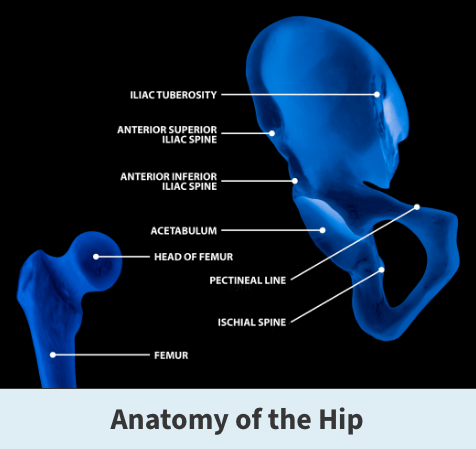Hip labral tears
Acetabular labrum tears
A labral tear of the hip is an injury to the labrum, the soft tissue that covers the socket (acetabulum) of the hip. Labral tears of the hip are caused by a wide variety of factors such as injury, structural problems, or degenerative issues. Symptoms can vary greatly for a hip labral tear, but they typically include pain and stiffness. Labral hip tears are treated in a nonsurgical manner, or with surgery in severe cases.
Anatomy

The hip is a ball and socket joint. The socket is inside the large pelvis bone (acetabulum) and the ball is the upper end of the thighbone (femoral head). A slippery tissue known as the articular cartilage covers the surface of the joint, creating a smooth surface that allows for the bones to glide easily across each other.
The labrum is a band of tough cartilage and connective tissue that lines the rim of the hip socket (acetabulum). It works to cushion the hip bone, which prevents the bones from directly rubbing against each other. The labrum also increases the stability of the joint by helping keep the leg bone in place.
About
An acetabular labrum tear, also known as the labral tear of the hip, is when the cartilage and tissue in the hip socket are damaged. There are many different reasons your acetabular labrum can tear. For example, some people may tear their labrum from an accident such as a fall or a car crash. Additionally, sports that involve the entire rotation of the hip, like golf, ballet, hockey, and soccer, can overwork the labrum, increasing the risk of tearing it.
While these types of activities and injuries can cause the labrum to tear, nearly 75% of torn acetabular labrum cases have no direct cause; they gradually happen over time. Labral tears of the hip are more common in women. They also occur more often in people who have abnormalities of the hip structure, like hip dysplasia and other conditions.
Symptoms
Labral tears of the hip can cause many different symptoms.
While some people may not experience any discomfort, others have sharp pain around the groin, which can extend into the upper leg or buttocks. Pain can either come on suddenly or develop gradually over time. Rotating your leg may also be particularly painful.
Labral tears of the hip often cause a feeling of the leg clicking or catching in the hip socket whenever you move it. It may also feel as though the leg is locking up.

Diagnosis
Your Florida Orthopaedic Institute physician will take a look at your symptoms, overall medical health, and medical history, followed by a medical examination. During the exam, your physician will have you flex and rotate your leg. They may decide you need an MRI or a different imaging test to confirm that you have a labral tear of the hip. But even after all these tests and examination, diagnosis is often difficult.
Treatment
There are both surgical and nonsurgical treatments available for labral tears of the hip. Nonsurgical treatments are typically the most common treatment option, as it is the least invasive and easiest option. If the damage is severe, or if nonsurgical treatments offer no relief, surgical options may be recommended. Your Florida Orthopaedic Institute physician will walk you through your options and determine which treatment plan is best for you.
Nonsurgical treatments
Nonsurgical treatments are usually the first steps to treating a labral tear of the hip. Your physician may begin by recommending using pain relieving medicines and resting the hip to help manage the pain. These steps may not be effective for healing the tear because the majority of the labrum gets little to no blood flow, which is crucial for natural healing.
Physical therapy may also be recommended to help heal a torn acetabular labrum, which helps build muscle strength to support the joint.
Surgical treatments
If nonsurgical treatments are ineffective, your Florida Orthopaedic Institute physician may recommend arthroscopic surgery. During the procedure, several small incisions are made to allow for several small tools, including a camera, to be inserted into the body. These tools are then used to either remove the torn tissue or repair it, depending on the severity of the injury. The camera is used to help see everything that is going on during the procedure.
Videos
Related specialties
- Anterior Hip Replacement
- Avascular Necrosis (Osteonecrosis)
- Groin Strains & Pulls
- Hamstring Injuries
- Hip Arthroplasty
- Hip Arthroscopy
- Hip Dislocation
- Hip Flexor Strains
- Hip Fractures
- Hip Hemiarthroplasty
- Hip Impingement Labral Tears
- Hip Muscle Strains
- Hip Pointers & Trochanteric Bursitis
- Iliopsoas Tenotomy
- Osteoarthritis of the Hip
- Osteoporosis
- Pelvic Ring Fractures
- Piriformis Syndrome
- Sports Hernias (Athletic Pubalgia)
- Thigh Fractures
- Thigh Muscle Strains
